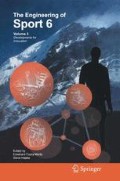Abstract
Ice hockey boards are equipped with protective glass to prevent the spectators from being hit by the puck. Although the height of the board with protective glass is 2.05m, this is not high enough to prevent the spectators from puck collisions — severe accidents have occurred in the past. This study investigates, which increase of height of the safety glass is necessary to significantly reduce the risk of severe puck injuries for the spectators.
For this reason the flight of the puck is simulated using a rigid body puck model. Flight curves from 29 different initial positions on the ice rink were calculated, using 12 different initial take off angles and the maximum initial speed and spin that has been determined experimentally with three top level players.
The simulations show that an increase of the security glass by 0.8 m will lower the relative frequency by 37%, of those shots with a potential to hit a spectator. The maximum velocity of such dangerous shots was decreased from 22.6 to 15.9 m/s. However, this reduced velocity and number of dangerous shots do not protect the spectators completely from injuries. The simulation model suggests that a barrier of 6,37 m protective glass leads to a 100% reduction of all dangerous shots.
Access this chapter
Tax calculation will be finalised at checkout
Purchases are for personal use only
Preview
Unable to display preview. Download preview PDF.
References
De Mestre N. (1990). The Mathematics of Projectiles in Sport, Cambridge University press, NY, USA, Chapter 7.5.
Gülich, H.A. (1988). Biomechanische Belastungsgrenzen. Aktualisierte Literaturstudie zur Belastbarkeit des Menschen beim Aufprall. Bundesanstalt für Straßenwesen Bereich Unfallforschung. Bergisch Gladbach, pp 35–53
Haug, E. J. (1989). Computer aided kinematics and dynamics of mechanical systems. Allyn and Bacon Series in Engineering Vol. 1 Basic Methods, Allyn and Bacon, Boston, MA. Chap. 9.3.
Potts J.R. & Crowther W.J. (2000). The Flow Over a Rotating Disc-wing, RAeS Aerodynamics Research Conference Proc., London, UK.
Author information
Authors and Affiliations
Editor information
Editors and Affiliations
Rights and permissions
Copyright information
© 2006 Springer Science+Business Media, LLC
About this paper
Cite this paper
Schwiewagner, C., Böhm, H., Senner, V. (2006). Simulation of Puck Flight to Improve Safety in Ice Hockey Arenas. In: Moritz, E.F., Haake, S. (eds) The Engineering of Sport 6. Springer, New York, NY. https://doi.org/10.1007/978-0-387-45951-6_28
Download citation
DOI: https://doi.org/10.1007/978-0-387-45951-6_28
Publisher Name: Springer, New York, NY
Print ISBN: 978-0-387-34680-9
Online ISBN: 978-0-387-45951-6
eBook Packages: EngineeringEngineering (R0)

